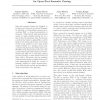250 search results - page 13 / 50 » Learning Probabilistic Models of Word Sense Disambiguation |
ACL
2001
15 years 1 months ago
2001
This paper describes automatic techniques for mapping 9611 entries in a database of English verbs to WordNet senses. The verbs were initially grouped into 491 classes based on syn...
CORR
1998
Springer
14 years 11 months ago
1998
Springer
Abstract. In many applications of natural language processing (NLP) it is necessary to determine the likelihood of a given word combination. For example, a speech recognizer may ne...
WWW
2007
ACM
16 years 18 days ago
2007
ACM
Name ambiguity is a special case of identity uncertainty where one person can be referenced by multiple name variations in different situations or even share the same name with ot...
CIARP
2004
Springer
15 years 5 months ago
2004
Springer
We present a method for extracting selectional preferences of verbs from unannotated text. These selectional preferences are linked to an ontology (e.g. the hypernym relations foun...
131
click to vote
JMLR
2012
13 years 2 months ago
2012
Open-text semantic parsers are designed to interpret any statement in natural language by inferring a corresponding meaning representation (MR – a formal representation of its s...

